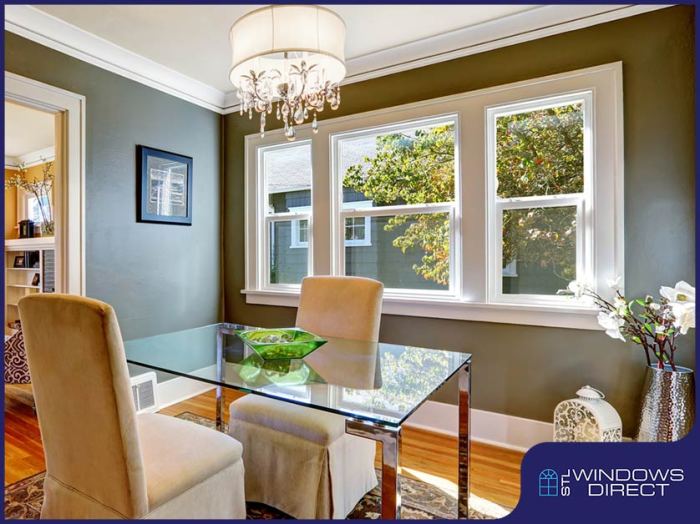Exploring the realm of energy efficiency in homes, this piece delves into the impact of new windows on reducing utility bills and enhancing insulation. With a focus on environmental benefits and installation tips, it's a must-read for those looking to upgrade their windows for energy savings.
The Importance of Energy Efficiency
Energy efficiency is crucial for homes as it not only helps reduce utility bills but also contributes to environmental sustainability. By investing in energy-efficient windows, homeowners can significantly decrease their energy consumption and costs.
Reducing Utility Bills
Energy-efficient windows are designed to keep the indoor temperature stable, reducing the need for heating and cooling systems to work overtime. This results in lower energy consumption, leading to reduced utility bills for homeowners.
Environmental Benefits
Improving energy efficiency in buildings, such as installing energy-efficient windows, can help lower overall energy demand. This, in turn, reduces greenhouse gas emissions and helps mitigate climate change. By using less energy, homeowners can contribute to a healthier environment for future generations.
How New Windows Enhance Insulation

New windows play a crucial role in improving insulation in homes, leading to increased energy efficiency and lower utility bills. By reducing heat transfer between the interior and exterior of a building, new windows help maintain a comfortable temperature inside, regardless of the weather outside.
Double or Triple-Pane Glass
One of the key features of new windows that enhance insulation is the use of double or triple-pane glass. These windows have multiple layers of glass with an insulating gas in between, creating a barrier against heat transfer. The additional panes and gas fillings significantly reduce heat loss in the winter and heat gain in the summer, making the indoor environment more energy-efficient.
Window Materials Comparison
- Vinyl Windows: Vinyl windows are known for their excellent insulation properties. They are low maintenance, cost-effective, and provide good thermal performance, making them a popular choice for energy-efficient homes.
- Wood Windows: Wood windows offer natural insulation and a classic look. While they require more maintenance compared to vinyl or fiberglass, they provide good thermal resistance, helping to keep the indoor temperature stable.
- Fiberglass Windows: Fiberglass windows are known for their durability and low thermal expansion. They offer excellent insulation properties, reducing heat transfer and improving overall energy efficiency in homes.
Types of Energy-Efficient Windows
When it comes to energy-efficient windows, there are several types available in the market that offer varying levels of insulation and energy savings. Each type has unique features that contribute to improving energy efficiency in buildings.
Low-E Coatings
Low-E (low emissivity) coatings are thin layers of metallic oxides applied to the glass surface of windows. These coatings help to reflect heat back to its source, keeping the indoor temperature consistent and reducing the need for heating or cooling.
By minimizing heat transfer through the windows, Low-E coatings play a significant role in improving energy efficiency in buildings.
Gas Fills (Argon or Krypton)
Some energy-efficient windows are filled with gases such as argon or krypton between the panes of glass. These inert gases are denser than air, reducing the transfer of heat and cold through the window. By creating a barrier that improves insulation, gas fills enhance the overall energy efficiency of the windows.
The use of argon or krypton gas fills is a common feature in modern energy-efficient window designs.
Installation and Maintenance of Energy-Efficient Windows
When it comes to energy-efficient windows, proper installation and maintenance are crucial to ensure optimal performance and energy savings. In this section, we will provide a step-by-step guide on installing new energy-efficient windows, discuss the importance of proper sealing during installation, and share tips on how to maintain these windows for long-term efficiency.
Installing Energy-Efficient Windows
Proper installation of energy-efficient windows is essential to maximize their performance. Follow these steps for a successful installation:
- Measure the window opening accurately to ensure a perfect fit.
- Remove the old window carefully, making sure to clean the area thoroughly.
- Apply a high-quality sealant around the window frame to prevent air leakage.
- Secure the new window in place and insulate around the frame to improve energy efficiency.
Importance of Proper Sealing
Proper sealing during window installation is crucial to prevent air leaks and maintain energy efficiency. The use of quality sealants and insulation materials can help create a tight seal, reducing heat loss and improving overall energy performance. Be sure to inspect the seals regularly to address any gaps or damage promptly.
Maintaining Energy-Efficient Windows
To ensure long-term performance and energy savings, follow these tips for maintaining energy-efficient windows:
- Clean the windows regularly to remove dirt and debris that can affect their efficiency.
- Check the seals and weatherstripping for any signs of wear or damage and replace them as needed.
- Inspect the frames for cracks or gaps and repair them to prevent air leakage.
- Consider applying a window film or using curtains to enhance insulation and reduce heat transfer.
Financial Incentives for Energy-Efficient Windows
Investing in energy-efficient windows not only helps reduce energy consumption and lower utility bills but also opens up opportunities for financial incentives that can further offset the costs of installation. Let's explore some of the financial benefits associated with energy-efficient windows.
Government Rebates and Tax Credits
- Many governments offer rebates or tax credits for homeowners who install energy-efficient windows as part of their efforts to promote sustainability and reduce energy consumption.
- These incentives can help offset the upfront costs of purchasing and installing energy-efficient windows, making them a more affordable investment for homeowners.
- It's essential to research and understand the specific rebates and tax credits available in your area to take full advantage of these financial benefits.
Property Value Increase
- Energy-efficient upgrades, such as installing energy-efficient windows, can enhance the overall value of your property.
- Homebuyers are increasingly prioritizing energy efficiency in their purchasing decisions, making properties with energy-efficient features more attractive and valuable in the real estate market.
- By investing in energy-efficient windows, you not only improve the comfort and sustainability of your home but also potentially increase its resale value in the future.
Long-Term Cost Savings
- While the initial cost of energy-efficient windows may be higher than traditional windows, the long-term cost savings can outweigh the upfront investment.
- Energy-efficient windows help reduce heat loss in winter and heat gain in summer, leading to lower heating and cooling costs throughout the year.
- Over time, the energy savings from efficient windows can add up significantly, providing homeowners with ongoing financial benefits and a positive return on investment.
Conclusive Thoughts
In conclusion, the journey through the realm of energy-efficient windows unveils a world of potential savings and environmental consciousness. From understanding insulation properties to financial incentives, the path to a more energy-efficient home is clear and enticing.
Frequently Asked Questions
Do energy-efficient windows really help reduce utility bills?
Yes, energy-efficient windows can significantly reduce heating and cooling costs by minimizing heat transfer.
What are Low-E coatings and how do they improve energy efficiency?
Low-E coatings are thin layers that reflect infrared light, helping to keep heat inside during winter and outside during summer, thus improving energy efficiency.
Are there any tax credits available for installing energy-efficient windows?
Yes, there are various government rebates and tax credits offered for installing energy-efficient windows as part of energy-saving initiatives.














